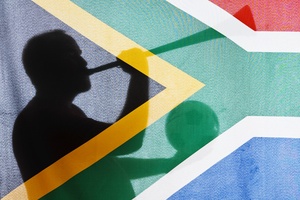Although England's performance in the World Cup has been a rollercoaster ride for its fans, the main talking point away from the football itself has been the atmosphere within the grounds and the use of the vuvuzela
Although England's performance in the World Cup has been a rollercoaster ride for its fans, the main talking point away from the football itself has been the atmosphere within the grounds and the use of the vuvuzela or the 'African horn', explains Jim Byard
Representations made prior to the Tournament to ban the vuvuzela on grounds that it would be a detriment to spectator enjoyment were refused by Sepp Blatter, the president of FIFA on the basis that vuvuzelas would provide an 'authentic' South African football crowd experience.
Since the opening game on 11 June each match has been accompanied by a dirge from the first to the ninetieth minute with most commentators describing the noise made by the vuvuzelas as a "swarm of bees", or "like watching a game in the presence of constant tinnitus".
Concerns were raised after the first games not just because Ronaldo and co had complained that vuvuzela noise had affected their concentration or that players couldn't hear the referee's whistle, but because noise could damage the hearing of spectators. Ingenious street traders have already picked up on safety concerns advertising hearing protection though business has reportedly not been brisk.
For those watching the games in the comfort of their own front rooms the solution is easy - turn down the volume.
However, noise readings amongst the crowds suggest that those watching the matches live will receive noise levels of around 113 decibels from a distance of two metres. Other reports suggest peak levels up to 130dBA.
To place such noise levels in context, 80dBA is described in the 2005 Noise at Work Regulations as being akin to a busy public house, or the noise of a vacuum cleaner. Similarly, 100 metres from a jet engine at take off would result in a level of around 140dBA.
Noise is accepted to double in intensity every three decibels. The present 2005 Noise Regulations require a system of hearing protection when workers are exposed to average levels of 85dBA or above over an eight hour working day. If we are to take the 113dBA reading as accurate, then it would require just over one minutes' exposure in an occupational setting to warrant provision of hearing protection.
The likelihood of harm? Despite high levels emitted by vuvuzelas, are they likely to cause permanent damage to hearing? Most reading this article will at some point in their lives have experienced partial deafness often associated with a ringing or whooshing sensation in their ears (tinnitus) following attendance at a disco or concert. There have been few studies into the effect of social noise on hearing. The Hearing Research Council, commissioned by the HSE, published a report in 1985 with a tag line - "no sound basis for leisure noise fears" suggesting that concerns in industry on the effect of social noise- particularly personal stereos and discotheque noisehad been overstated, suggesting that unless noise exposure was regular and sustained it was unlikely to cause permanent damage.
Given the relatively short periods of exposure - most football fans will not be exposed to such noise for in excess of 90 minutes- the prospect of fans suffering from anything more than a short term reduction in hearing acuity and transient tinnitus is remote. Watching the 2010 World Cup may cause many things but permanent hearing loss and tinnitus is unlikely to be one of them.
Jim Byard is a partner specialising in disease claims at law firm Weightmans LLP.


